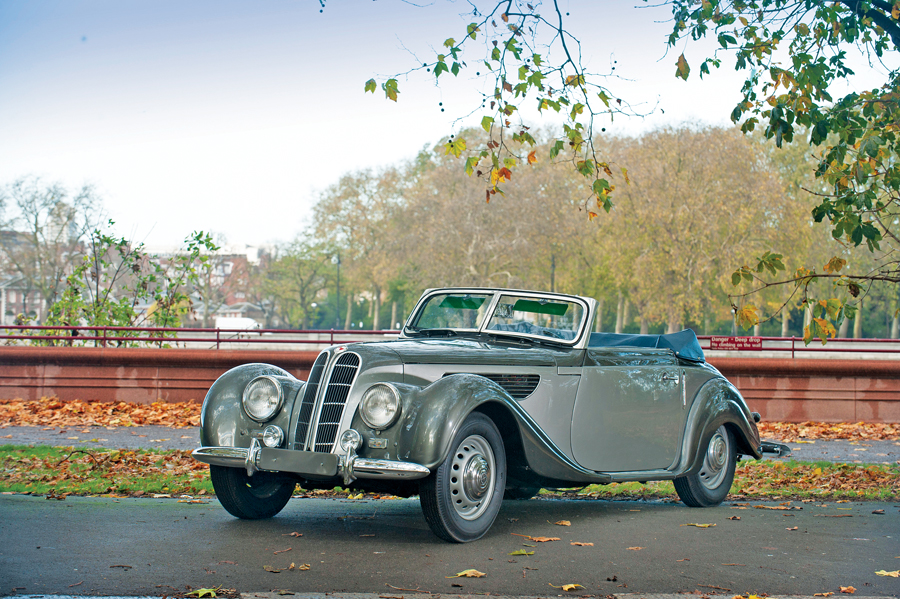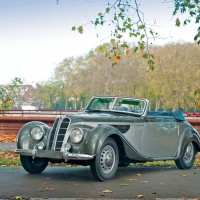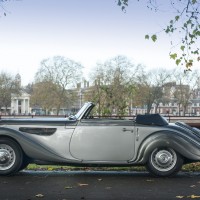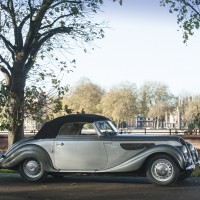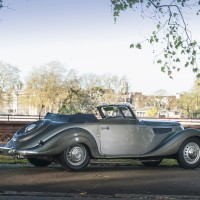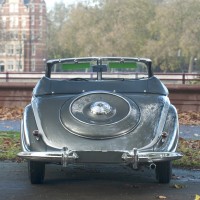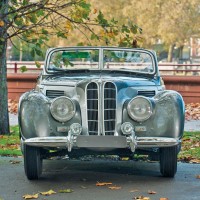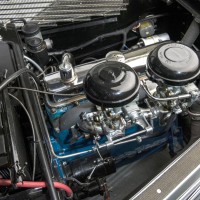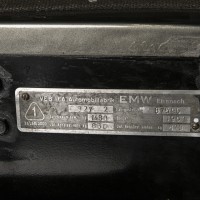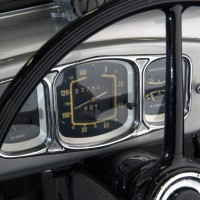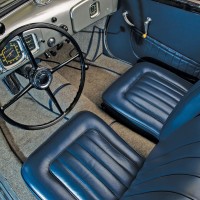SCM Analysis
Detailing
| Vehicle: | 1953 EMW 327 Cabriolet |
| Years Produced: | 1952–55 |
| Number Produced: | 505 |
| Original List Price: | N/A |
| SCM Valuation: | Median to date, $211,750; high sale, $300,408 |
| Chassis Number Location: | Plate on scuttle |
| Engine Number Location: | Right side of block towards the front |
| Club Info: | BMW Historic Motor Club |
| Website: | http://www.bmwhistoricmotorclub.co.uk |
| Alternatives: | 1937–41 BMW 327, 1937–41 Mercedes-Benz 230 (W143), 1931–42 Lancia Artena |
| Investment Grade: | B |
This car, Lot 331, sold for £85,500 ($129,332), including buyer’s premium, at Bonhams’ RAF Museum, Hendon, London, U.K., sale on December 10, 2015.
Strange, this: When I was looking at this car, an employee of the RAF Museum came up and asked me what it would likely sell for. I said, “£80k ($125k). But if it had been a BMW, nearer £200k ($300k).”
The red-badged copy, however accurate, will never be worth as much as the “real” thing — even though they came out of the same factory. An ersatz BMW, if you will, never commands the price of the blue-badged original.
Can you equate this to Dacia hammering out old Renaults, Hindustan continuing production of the ’50s Morris Oxford well past its best-by date, or even the Iranians soldiering on with the miserable Hunter right up to 2005? Not quite: BMW’s 327/328 was such an advanced design for its time that it was still capable of holding its head above the opposition into the ’50s.
There’s little difference between this and the pre-war BMW — the EMW 327 was a continuation of the 327 coupé and cabriolet, virtually identical apart from having front-hinged doors.
On the wrong side of the line
All this came about when BMW’s factory in Eisenach, or what was left of it after Allied bombing, ended up on the wrong (Russian) side of the wire when the dust had settled after World War II. The Eisenach factory was in the Soviet Occupation Zone.
This was just the latest episode in the company’s turbulent history. The firm began making cars in 1898, and was reorganized as Dixi having already suffered war reparations, which included removal of equipment, after World War I ended in 1918. Then BMW took over in 1928. Car production stopped in 1942, and the factory shifted to making aircraft engines (how BMW started, remember) plus motorcycles for the Wehrmacht.
From BMW to EMW
At the end of World War II, the Americans handed over the state of Thuringia to the Russians, and the factory became a Soviet Stock company, renamed Sowjetische AG Maschinenbau Awtowelo, Werk BMW Eisenach (Soviet Awtowelo Co., Eisenach BMW Works).
Rather than strip what remained of the factory bare — their usual treatment of valuable German assets — the Russian owners restarted production of the pre-war designs. Both cars and motorcycles were made bearing BMW’s distinctive quartered emblem in the blue and white colors of the Free State of Bavaria (and not, apparently, originally designed to resemble a spinning propeller).
In 1952 EMW became a state-owned company of the German Democratic Republic, and Munich-based BMW got its trademark back — though bear in mind it hadn’t produced any cars from 1945 to 1951.
As a result, the Eastern Bloc offshoot adopted the name EMW (Eisenacher Motoren Werke) and changed the blue sections of its badge to red. Production continued until 1955, when the company, by then known as VEB Automobilwerk Eisenach, dropped its old BMW-based models and began manufacturing IFA F9s, based on pre-war DKWs, and the new Wartburg 311.
Car production finished there for good in 1990 with the reunification of Germany, and now only part of the old factory remains. It is now home to the Automobilbau Museum Eisenach.
What’s in a badge?
So the luxurious BMW 300-based cars were rather different from the Eisenach factory’s usual staple of economy cars built to mobilize a nation.
Although the 328 gets all the attention, the 327 was built in larger numbers — 1,306 base-model coupes and cabrios between 1937 and 1941, plus 569 with the higher-power 328 engine (and that hemi-head engine really makes a price difference).
It’s not clear how many of the post-war (1946–55) 327s were branded as BMWs and how many as EMWs, but 505 were produced in total.
This one, in the previous ownership for 31 years and just having spent five years in the classic car collection of the Federation Hellenique D’Epoque in Automotive Museum Nafplias in Greece before being offered via a dealer in London for a time, was in good order, having been recently restored.
I didn’t much care for the chrome rocker cover or modern coil and distributor, but both are easy enough to put right, and there was at least a period-looking black battery. The speedo needle appeared stuck on 100 km/h, and the oil pressure gauge on 2.5, but the rest of the interior was in fine shape, having recently been re-trimmed.
Of course, if you just wanted to impress people, it would be easy enough to put BMW badges on it, and most folk would be none the wiser.
However, EMW has its own historical value, and like Horch and DKW, has its own place in German (and therefore world) automotive order.
With a similar — but Bristol-engined — 1952 car recently advertised in SCM’s classifieds at $87,750, I’d say an astute buyer correctly valued this car. Well bought. ♦
(Introductory description courtesy of Bonhams.)
